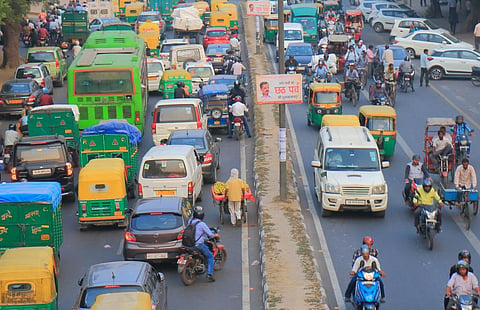Decongesting roads just as vital as introducing EVs to transform India’s transport sector. But who’s listening?
The Indian automotive industry is almost a century old and is a large exporter of vehicles. The first time that a vehicle came on the road in India was in 1897. Nobody knew back then what was to ensue — that a harmless means of convenience will become such a menace of modern times.
The International Energy Agency’s latest report tells us that road transport presently accounts for 12 per cent of India’s energy-related CO2 emissions and is a key contributor to urban air pollution.
Air pollution, public health hazards and climate change are the trio of killers created by modern internal combustion engine vehicles. To solve this existential crisis, the automotive innovators have devised zero-emission vehicles (ZEV).
These vehicles are hitting the roads across the world. Piggybacking on the success of e-two wheelers and e-three wheelers, e-passenger cars and now even e-trucks are scripting their own glorious stories in India.
While ZEVs are a beacon of hope for fighting against climate change, air pollution and their resulting hazards, there is a glaring problem with having too many vehicles, which we often laugh off. This problem is traffic congestion.
With the festive season approaching in Delhi, the city’s traffic police identified 117 congestion points in the city on October 6, 2023. This was the result of a survey that was conducted to better understand road engineering and find ways to decongest the roads.
Delhi ranked 34 in the TomTom Traffic Index Ranking 2022. Bengaluru and Pune ranked ahead of Delhi in the top 10.
On July 29, 2016, the newspaper The Indian Express reported that thousands of commuters were stranded in Gurgaon due to waterlogging on NH-8, causing massive traffic jams. While that day’s traffic jam may have been attributed to rains, traffic congestion is omnipresent in the Indian cities.
It leads to energy wastage, whether it is through burning of fossil fuels or exhaustion of electricity stored in the lithium-ion batteries of cars. It is also a mental health hazard, which is a silent killer and just as dangerous as lungs blackened due to air pollution.
In January 2023, The Indian Express reported, “If there is one thing that is consistently occurring on the roads of Karnataka without a single day’s break as much as across India and many parts of the world too, it is ‘road rage’. And it is not just common, it is so rampant that it happens probably at multiple locations in a single square kilometre every few hours, especially in high-density urban locations like Bengaluru.”
As per investigative interviews, the Bangaloreans are mulling a congestion tax, the Delhiites are still battling their age-old norm of polluted Diwali skies and for Mumbaikars, monsoons become a traffic nightmare every year.
Singapore, which had one of the densest vehicle populations in the world, took a major decision in 1990 to address the crisis. According to the Singapore Infopedia, an online information base, “A Certificate of Entitlement (COE) in Singapore represents the right to vehicle ownership in Singapore for a period of 10 years. COEs are integral to the Vehicle Quota System (VQS), a landmark scheme implemented to regulate the growth of the vehicle population in Singapore, which is among the densest in the world. The VQS determines the exact number of vehicles of various categories allowed on the road. The VQS was implemented on May 1, 1990 and the first bidding under the system started on 2 April 1990. Public buses, school buses and emergency vehicles are exempted from this scheme.”
The solutions are limited only by our own imagination. Implementation is a matter of executive prowess, political will and public consensus.


